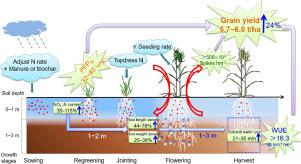当前位置:
X-MOL 学术
›
Agric. For. Meteorol.
›
论文详情
Our official English website, www.x-mol.net, welcomes your
feedback! (Note: you will need to create a separate account there.)
Sustainable high yields can be achieved in drylands on the Loess Plateau by changing water use patterns through integrated agronomic management
Agricultural and Forest Meteorology ( IF 5.6 ) Pub Date : 2021-01-01 , DOI: 10.1016/j.agrformet.2020.108210 Wenjia Yang , Yulin Li , Weijian Liu , Shiwen Wang , Lina Yin , Xiping Deng
Agricultural and Forest Meteorology ( IF 5.6 ) Pub Date : 2021-01-01 , DOI: 10.1016/j.agrformet.2020.108210 Wenjia Yang , Yulin Li , Weijian Liu , Shiwen Wang , Lina Yin , Xiping Deng

|
Abstract Low yields of winter wheat are common throughout the Loess Plateau due to the region's erratic precipitation and the mismatch between the rainy season and the winter wheat growing season. In order to achieve sustainable high yields of winter wheat in this area, we set 6,000 kg hm−2 as our yield goal and investigated the effects of four types of management systems, including a conventional farmers’ management system and three integrated management systems, on winter wheat production over five consecutive years. The management practices varied in terms of seeding rates, nitrogen (N) application strategies, and application of manure or biochar. Our five-year study revealed that the average winter wheat yield under a manure integrated system (MIS) or a biochar integrated system (BIS) could achieve nearly 6,000 kg hm−2 while also enhancing water use efficiency (WUE) to 1.63–1.69 kg m−3. The high yields under MIS and BIS were mainly due to the large plant population that these systems permitted during the whole growing season, which was supported by favorable soil N levels (NO3−–N content) and sufficient water supply. The high WUE under both systems was mainly due to decreased loss of precipitation (i.e., increased storage in the soil) during early growth stages (from sowing time to regreening stage) and increased use of subsoil water (100–300 cm) during late growth stages (from regreening to harvest time) by the large root system. In addition, the annual evapotranspiration under MIS and BIS was much lower than the annual precipitation in this area. Therefore, MIS and BIS are likely to be useful integrated management systems enabling sustainable high yields of winter wheat in the Loess Plateau through the regulation of water use patterns in both spatial and temporal terms.
中文翻译:

通过综合农艺管理改变用水模式,可以在黄土高原的旱地实现可持续的高产
摘要 黄土高原地区降水不稳定,雨季与冬小麦生长季不匹配,导致黄土高原冬小麦低产现象普遍存在。为实现该地区冬小麦的可持续高产,我们将6000 kg hm-2作为我们的产量目标,并考察了四种管理制度,包括传统农户管理制度和三种综合管理制度,对冬小麦的影响。连续五年生产冬小麦。管理实践在播种率、氮 (N) 施用策略以及粪便或生物炭的施用方面各不相同。我们五年的研究表明,在粪肥综合系统 (MIS) 或生物炭综合系统 (BIS) 下,冬小麦平均产量可达到近 6,000 kg hm-2,同时还将用水效率 (WUE) 提高到 1.63–1.69 kg m-3。MIS 和 BIS 下的高产量主要是由于这些系统在整个生长季节允许的大量植物种群,这是由有利的土壤 N 水平(NO3--N 含量)和充足的供水支持的。两种系统下的高 WUE 主要是由于早期生长阶段(从播种到重新绿化阶段)降水损失减少(即土壤中的储存量增加)和生长后期对底土水(100-300 cm)的使用增加大根系的阶段(从重新绿化到收获时间)。此外,MIS和BIS下的年蒸散量远低于该地区的年降水量。所以,
更新日期:2021-01-01
中文翻译:

通过综合农艺管理改变用水模式,可以在黄土高原的旱地实现可持续的高产
摘要 黄土高原地区降水不稳定,雨季与冬小麦生长季不匹配,导致黄土高原冬小麦低产现象普遍存在。为实现该地区冬小麦的可持续高产,我们将6000 kg hm-2作为我们的产量目标,并考察了四种管理制度,包括传统农户管理制度和三种综合管理制度,对冬小麦的影响。连续五年生产冬小麦。管理实践在播种率、氮 (N) 施用策略以及粪便或生物炭的施用方面各不相同。我们五年的研究表明,在粪肥综合系统 (MIS) 或生物炭综合系统 (BIS) 下,冬小麦平均产量可达到近 6,000 kg hm-2,同时还将用水效率 (WUE) 提高到 1.63–1.69 kg m-3。MIS 和 BIS 下的高产量主要是由于这些系统在整个生长季节允许的大量植物种群,这是由有利的土壤 N 水平(NO3--N 含量)和充足的供水支持的。两种系统下的高 WUE 主要是由于早期生长阶段(从播种到重新绿化阶段)降水损失减少(即土壤中的储存量增加)和生长后期对底土水(100-300 cm)的使用增加大根系的阶段(从重新绿化到收获时间)。此外,MIS和BIS下的年蒸散量远低于该地区的年降水量。所以,











































 京公网安备 11010802027423号
京公网安备 11010802027423号